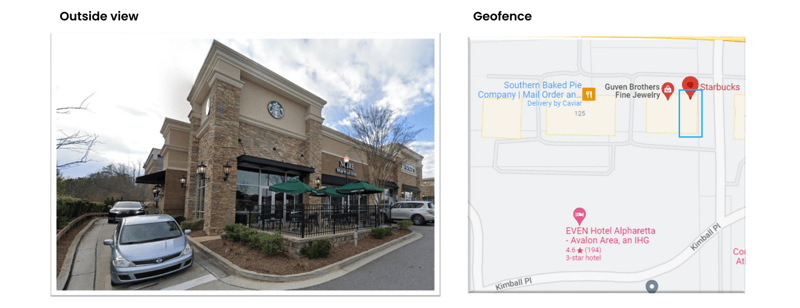What is geofencing marketing exactly?
Geofencing marketing is a powerful tool for restaurants looking to add location-based targeting to their mix of advertising. It’s a great way to target a local crowd and attract more customers to your customers.
A geofence is a virtual boundary created around a location, or points of interest (POIs). Marketers can then send targeted ads to prospective customers who have walked into a geofence.

How do marketers know if someone has walked into a geofence? Marketers use mobile location data.
Think about this: when was the last time you walked into a restaurant, gym, or grocery store without a phone?
Chances are, never. Similarly, your customers are tethered to their mobile phones and most likely have location services enabled on one app — that's all it takes.
Once your audience is captured in a geofence, marketers are able to target their customers on their streaming TVs, mobile apps, and browsers. In this guide, we'll explore the benefits of geofence marketing, how it works, and best practices to follow to help you attract more customers to your restaurants.
Benefits of Geofencing Marketing for Restaurant Marketers
Geofencing marketing offers numerous benefits for restaurant marketers. Here are some of the most notable advantages:
1) Increased Foot Traffic: Geofencing marketing allows marketers to target users in close proximity to their restaurant, increasing the likelihood that they'll visit and dine at their establishment.
2) Exposure: Prospective customers can receive targeted ads almost immediately after entering a geofence for up to 30 days. Restaurant ads can be showcased on streaming TV, mobile apps, and desktop browsers.
Did you know that you can now use AI to facilitate the creation of video ads? RestaurantGeofencing.com now offers AI-Powered videos that you can use for social media, streaming TV ads, and more!
3) Unsaturated Advertising Channel: Because geofencing marketing is an emerging technology, this advertising channel is not as competitive as other modes of advertisement like pay-per-click advertising. This leads to a lower cost per acquisition for customers.
The Ingredients for Successful Geofencing Marketing at RestaurantGeofencing.com
Geofencing marketing at RestaurantGeofencing.com is comprised of the following components:
- Customer Insights: We have partnered with Placer.ai to use historical mobile data to provide a comprehensive report that unveils the high-converting locations for your customers. Find out where customers live, work and play!
- Strategic Geofences: We place virtual boundaries around popular locations that your customers frequent. Some local destination retail locations include shopping malls, restaurants, gyms, college campuses, churches, high schools and theatres. Restaurant marketers can also geofence local events such as college football games, farmer's markets, concerts and tradeshows.
- Omnichannel Exposure: Stir up an appetite via omnichannel advertising. Showcase your restaurant to a hyperlocal audience on streaming TV, social media, and digital display and banner ads on mobile apps and browsers.
- Transparent Reporting: Assess your campaign performance with your custom dashboard link to gauge the ROI of your campaign. Access key metrics such as CTR, website conversions, and unique walk-ins for your restaurant.
- Continual optimization: Set it and forget it? Not at RestaurantGeofencing.com. Our data team continually reviews geofencing campaigns and provides actionable insights to continue improving campaign performance. This ensures campaigns remain responsive to market changes such as seasonality and remain aligned with your goals.
Best Practices for Geofencing Marketing for Restaurant Marketers
To make the most of geofencing marketing, restaurant marketers should follow these best practices:
1) Define Your Target Audience: Identify the customers you want to target and create geofences around locations where they are likely to be, such as nearby competitors or popular attractions.
2) Create Compelling Messaging: Craft messaging that is personalized, engaging, and relevant to the user's location and behavior, highlighting the unique features and offerings of the restaurant.
3) Set Clear Objectives: Define your goals for geofencing marketing, such as driving foot traffic, increasing sales, or building brand awareness.
4) Monitor and Optimize: Monitor your geofencing campaigns regularly and make adjustments based on performance data to improve ROI and drive better results.
Empty tables? Try geofencing with the restaurant geofencing experts!
If you're a forward-thinking restaurant marketer looking for more customers, book a quick discovery call with us to learn more!
Suggested reading:
- Geofencing: The Secret Sauce for a Tasty QSR Marketing Plan
- 6 Advanced Restaurant Marketing Strategies to Differentiate Your Brand and Drive Foot Traffic
- How can restaurant marketers use ChatGPT?
Contact us with your questions below.

.jpg)

 RestaurantGeofencing.com is owned and operated by the team at Intrinsic Digital. We are a group of digital marketers focused solely on implementing geofencing technology for our restaurant clients, eliminating the barriers to add this emerging technology into their local restaurant marketing strategies. We equip our clients with the most advanced technology available in location-based marketing.
RestaurantGeofencing.com is owned and operated by the team at Intrinsic Digital. We are a group of digital marketers focused solely on implementing geofencing technology for our restaurant clients, eliminating the barriers to add this emerging technology into their local restaurant marketing strategies. We equip our clients with the most advanced technology available in location-based marketing.